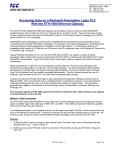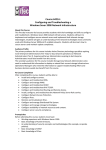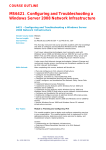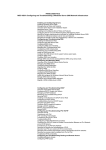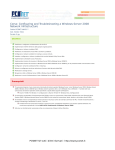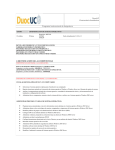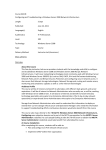Download CONFIGURING AND TROUBLESHOOTING A WINDOWS SEVER
Transcript
CONFIGURING AND TROUBLESHOOTING A WINDOWS SEVER 2008 NETWORK INFRASTRUCTURE Duration: Five Days Course Objectives This five-day instructor-led course provides students with the knowledge and skills to configure and troubleshoot a Windows Sever 2008 network infrastructure. Students will learn to implement and configure secure network access and implement fault tolerant storage technologies. Students will gain an understanding of the network technologies most commonly used with Windows Server 2008 and IPenabled networks. Students will also learn how to secure servers and maintain update compliance. At Course Completion After completing this course, students will be able to: Install and configure servers. Configure and troubleshoot DNS. Configure and manage WINS. Configure and troubleshoot DHCP. Configure and troubleshoot IPv6 TCP/IP. Configure and troubleshoot Routing and Remote Access. Install, configure, and troubleshoot the Network Policy Server Role service. Configure Network Access Protection. Configure IPsec. Monitor and troubleshoot IPsec. Configure and manage Distributed File System. Configure and manage storage technologies. Configure availability of network resources and content. Configure server security compliance. Who Should Attend The primary audience for this course includes Active Directory technology specialists aspiring to be Enterprise Administrators (Tier 4 day-to-day network operations) or Network Administrators (Tier 2). Experienced Server Administrators aspiring to be Enterprise Administrators would also benefit from this course. The secondary audience for this course includes Storage Area Network Administrators who need to understand this information to deploy or extend their current storage infrastructure. Operations Managers who need this information to support troubleshooting efforts and business decisions would also benefit from this course. Before attending this course, students must have: Working experience with Windows Server 2003. Basic knowledge of Active Directory. An understanding of security concepts and methodologies (for example, corporate policies). Basic knowledge of DHCP. Basic knowledge of IPsec. Configuring and Troubleshooting IPv6 TCP/IP Course Content Installing and Configuring Servers This module explains how to identify the appropriate usage scenario and installation type for a server and then install and configure appropriate server roles and features. After completing this module, students will be able to: Identify the system requirements and process for installing Windows Server 2008. Describe the difference between server roles and features. Describe the benefits of and roles supported by a Server Core installation. Configuring and Troubleshooting DNS This module explains how to configure, manage and troubleshoot DNS server and zone properties to be used in a secure environment. After completing this module, students will be able to: Install the DNS Server role. Configure the DNS Server role to support various query types. Configure DNS zones. Configure DNS zone transfers. Manage DNS zone records and troubleshoot DNS using various tools. Configuring and Managing WINS This module explains how to configure, manage and troubleshoot WINS servers. After completing this module, students will be able to: Install and configure the Windows Internet Name Service. Manage WINS client records. Configure and manage WINS replication. Migrate a WINS infrastructure to DNS. Configuring and Troubleshooting DHCP This module explains how to configure, manage and troubleshoot a DHCP environment supporting an IPV4 infrastructure. After completing this module, students will be able to: Describe how DHCP works. Configure DHCP scopes and options. Manage a DHCP database. Monitor and troubleshoot DHCP. Secure DHCP. This module explains how to configure and troubleshoot static and dynamic IPv6 addresses, including subnet prefix lengths, gateways and DNS servers. After completing this module, students will be able to: Describe the benefits and considerations of IPv6. Describe how IPv6 can coexist with IPv4 environments. Describe IPv6 tunneling technologies used to interoperate with IPv4 networks. Describe the process used to migrate from IPv4 to IPv6. Troubleshoot IPv6 connectivity. Configuring and Troubleshooting Routing and Remote Access This module explains how to configure and troubleshoot Routing and Remote Access Services. After completing this module, students will be able to: Install and configure the Routing and Remote Access service. Configure VPN access. Configure network policies. Configure a connection profile using the Connection Manager Administration Kit. Troubleshoot Routing and Remote Access. Installing, Configuring, and Troubleshooting the Network Policy Server Role Service This module explains how to install, configure and troubleshoot the Network Policy Server Role service. After completing this module, students will be able to: Install and configure the Network Policy Server role. Configure a RADIUS client and server. Describe NPS authentication methods. Monitor and troubleshoot a Network Policy server. Configuring Network Access Protection This module explains how to configure and manage NAP for DHCP, VPN, and 802.1X. After completing this module, students will be able to: Describe the benefits and uses of NAP. Describe how NAP works in various access scenarios. Configure NAP. Monitor and troubleshoot NAP. Configuring IPsec This module explains how to configure and test IPsec. Course Content subject to change without prior notice After completing this module, students will be able to: Describe the benefits and uses of IPsec. Configure Connection Security rules. Configure IPsec NAP enforcement. Manage updates using WSUS. Monitoring and Troubleshooting IPsec This module explains how to monitor and troubleshoot IPsec. After completing this module, students will be able to: Monitor IPsec activity. Troubleshoot IPsec. Configuring and Managing Distributed File System This module explains how to configure and manage Distributed File System. After completing this module, students will be able to: Describe the Distributed File System. Manage DFS namespaces. Configure DFS replication. Configuring and Managing Storage Technologies This module explains how to configure and troubleshoot file system storage technologies included with Windows Server 2008. After completing this module, students will be able to: Describe storage management solutions included in Windows Server 2008. Manage storage using File Server Resource Manager (FSRM). Configure quota management using FSRM. Implement file screening using FSRM. Manage storage reports. Configuring Availability of Network Resources and Content This module explains how to describe and configure backup and recovery methods. After completing this module, students will be able to: Back up data. Configure shadow copies. Provide server and service availability. Configuring Server Security Compliance This module explains how to configure and analyze server security and security update compliance. After completing this module, students will be able to: Secure a server role within a Windows infrastructure. Secure servers using security templates. Configure an audit policy. Describe the use of Windows Server Update Services. Course Content subject to change without prior notice



